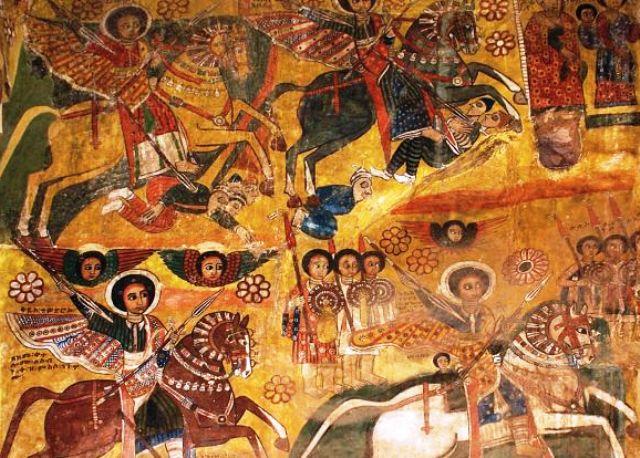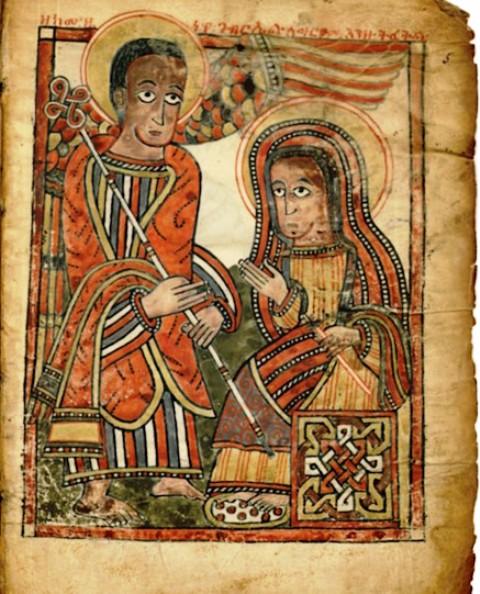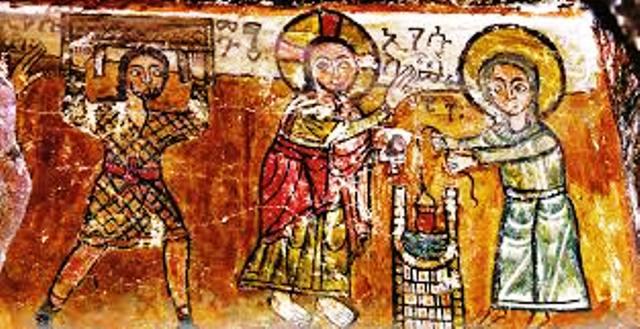
Habesha or Abesha
The Habesha people and the words origins have long perplexed scholars, scientists and modern man in general.The current inhabitants of the land commonly believed to be the location of the Habesha are also in disputes as to the true meaning of the word and the people it refers to.
Historically, the Kingdom of Axum (Aksum), its land, people, and commerce is widely believed to have inspired the meaning behind the word "the Habesha".

Though hard to prove, researchers are in common agreement that the Kingdom of Axum was created around the time of 300 BCE.
Little evidence has been found on the origins of this kingdom, but the kingdom of D'mt located in Yeha, which is not far from Axum is considered to be its successor.
The Axumite Kingdom (150 BC - mid 12th century) was a very successful and powerful civilization with wide reaching international influence that was primarily through their extensive trade in exotic items (e.g. ivory, incense) that were brought from deeper within the African continent.
The Axumites, no doubt had a monopoly over the items originating from within the interior of Africa.
At one point, Axum had control over land in the west (Nubian Kingdom of Meroe), in the south (Omo River), in the north (southern Egypt), in the east (Gulf of Aden), as well as, land in the Southern Arabian kingdom of the Himyarites and parts of western Saudi Arabia.

Descendants of this kingdom are usually attributed to the Amhara, Tigre (Eritrean included), Gurage, and Harari peoples of current day Ethiopia.
Lacking extensive research, prior to the 20th century, the Sabean theory held sway; it is believed to have been spurred on by what some might call a "Eurocentric" based belief system.
The theory was first reported in the 16th century by the German orientalist Hiob Ludolf and later reasserted by the Italian scholar and orientalist Carlo Conti Rossini in the early 1900's.
It purported that South Arabian tribes, chiefly the Habashat in 1000 B.C. moved from their homeland of which was in the area of current day Yemen, crossed the Red Sea and inhabited the land in what today is Eritrea.
The Sabean theory goes on to say that these migrants brought with them their South Arabian culture, language and alphabets and this would eventually evolve into the Ge'ez language and writing system.

The underlying belief was to maintain the Eurocentric ideology that Africans were not capable of having a culture and history, therefore leaving them susceptible to being colonized for their own benefit.
Today, the Sabean theory has been proved to be false and linguists have reported that Ge'ez did indeed have origins from a different branch of the Semitic peoples.
There is no evidence found in the many South Arabian inscriptions of there ever having been a large scale migration to present day Eritrea.
Even the so called "Habashat" tribe is nowhere to be found in the surviving records of the ancients.
Members of the Ge'ez speaking peoples of both the pre-Axumite and Axumite kingdoms were therefore only modestly affected by the influence from their Sabaean neighbors across the waters.
Ge'ez would eventually lead to several languages in Ethiopia, mainly the Tigrigna, Amharic, Harari and Gurage languages.

The earliest uses of the term ze Habesha are found in the in the 2nd and 3rd century AD, which was referring to the Axumites and their kingdom.
A 200 AD Sabaean inscription describing the details of the defeat of the King "GDRT" of Axum and "ḤBŠT", the term "Habashat" here seems to refer to a group of peoples, instead of a specific ethnicity.
Scholar and South Arabian specialist, Eduard Glaser reported that the hieroglyphic term "hbstjw" was used in 1460 B.C. for the first time by Queen Hatshepsut to refer to the "incense producing peoples in Punt land (modern day Eritrea and northeastern Ethiopia).
According to all Axumite inscriptions studied by scholars, the people never referred to themselves as Habesha, it probably just meant "incense producers" to them at the time.

Habesh in Arabic refers to the highland plateau on the east of the Nile River, which is considered to be the source of all its water. The people inhabiting this area were called Habshi in Arabic, as well.
The word Habesha, most likely evolved from the Ge'ez word "ḤBŚ" which was in turn vocalized into "Ḥabaśā".
By the middle of the 4th century, the Axum King Ezana would use the Greek word Ityopya instead of Habesha, on stone inscriptions to refer to his Kingdom of Axum.
The once powerful Yemeni kingdoms began their gradual decline by the end of the 8th century, and with this the production and trade of incense shifted to the Horn of Africa.
Since the name given to incense collectors/producers was "Habesha", the term was used by merchants and travelers to refer to the land and inhabitants of the Horn. In time, the people of the Horn would adopt this terminology to refer to themselves.
In 1557, land taken from the Habesha by the Ottomon Empire, would also bear the name "Habesh" or "Habeshistan". The Arabs would refer to it as Ḥabaš.
The Habesh Eyalet province under Ottoman rule comprised of not only the modern day Eritrean port cities of Hergigo (Arkiko) and Massawa, but also Saudi Arabia's city of Jeddah, the Sudan's Suwakin, and Yemen's Aden.
By the 16th century with the arrival of Portuguese religious missionaries into the interior of current day Ethiopia, they would take the "H" out of Habesha and use the name Abesha instead.
This would also evolve into its Latin version progressively, from Abassia to Abassinos and later to Abessina and finally into Abyssinia.
Abyssinia would be used for centuries to refer to the land of the Habesha, even though they themselves never used the term, instead opting for King Ezana's term: Ethiopia.

Today, there are some Ethiopians who believe that the term the Habesha originated from the biblical Ham and Shem.
Ham would represent the indigenous Hamitic or Cushitic people intermixing with the Shem or Semites from Yemen.
"Be" meaning "with" in Amharic, would be used as: Ham be Shem, leading to Habesha or "dibliq" mixed peoples.
